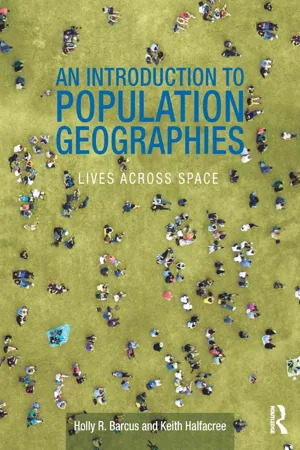Geography
Ravenstein's Laws of Migration
Ravenstein's Laws of Migration are a set of principles formulated by Ernst Georg Ravenstein in the late 19th century to explain patterns of human migration. The laws highlight factors such as distance, age, gender, and economic opportunity as key determinants of migration. They also emphasize the idea that migration is a process influenced by push and pull factors, and that most migrants tend to move short distances.
Written by Perlego with AI-assistance
Related key terms
1 of 5
3 Key excerpts on "Ravenstein's Laws of Migration"
- eBook - ePub
An Introduction to Population Geographies
Lives Across Space
- Holly R. Barcus, Keith Halfacree(Authors)
- 2017(Publication Date)
- Routledge(Publisher)
Chapter 1 ) that assume it is open to objective description and typically expressing generalizable regularities.Between 1876 and 1889, a German-born former cartographer for the British War Office named Ernst Georg Ravenstein published around eleven laws of migration, presented in Table 5.5 . These express the methodological individualism of the individual as the central “unit of analysis” (Samers 2010: 54–55). Ravenstein derived his laws from nineteenth-century British census data, supplemented in his final paper by data from censuses in North America and mainland Europe. All his laws, excluding the fifth, were more or less accurate accounts of migration across the Global North at the time. Many remain true today and indicate “some persistent patterns and processes” (Samers 2010: 56). Consequently, Ravenstein’s laws have had lasting importance for Population Geography (Box 5.2 ). Nevertheless, they leave the key challenge of explaining why they are or have been true, since they lack explicit theoretical grounding (Woods 1982).To provide such grounding, and predating the Quantitative Revolution (1.3.3 ), academics attempted from the 1940s onwards to extend laws of Physics to the human sphere in the form of the gravity model - eBook - ePub
People on the Move
Studies on Internal Migration
- R.M. Prothero, Leszek Kosiński(Authors)
- 2023(Publication Date)
- Routledge(Publisher)
The dimensions of such a matrix would be designated by: time (temporary, permanent); distance (long, short); boundaries crossed (internal, external); areal units involved (between communities, counties, states); decisionmaking (voluntary, impelled, forced); numbers involved (individual, mass); social organization of migrants (family, clan, individual); political organization of migrations (sponsored, free); causes (economic, non-economic); aims (conservative, innovative). A further discussion of migration typology followed by a classification of mobility in Africa follows in a paper in this present volume (Gould and Prothero). Migration laws Following an extensive empirical enquiry on internal migration, first in Britain and later in twenty other countries, Ravenstein published two seminal papers in the 1880s in which he postulated his ‘laws of migration’ (Ravenstein 1885, 1889). He thus reacted to an earlier study of Farr who remarked that migration appeared to go without any definite law (Farr 1876). Ravenstein included five explicit and two implicit statements concerning patterns and distance of migration, migratory streams, migration motives, and characteristics of migrants. Recently, Lee has returned to the same theme and restated Ravenstein’s laws in a series of hypotheses about the volume of migration under varying conditions, the development of stream and counterstream and the characteristics of migrants (Lee 1966, 295-7) - eBook - ePub
Migration Theory
Talking across Disciplines
- Caroline B. Brettell, James F. Hollifield, Caroline B. Brettell, James F. Hollifield(Authors)
- 2022(Publication Date)
- Routledge(Publisher)
Geographers bring to migration an empirical orientation (often through field work), a facility with spatial thinking expressed through mapping and modeling, an inclination to consider society–environmental dynamics, and a sensitivity to scale that ranges from the individual to the global. In addition, geographers share with practitioners of many disciplines an appreciation for how migration impacts places and that the experience of migrants varies greatly by locality and the individual characteristics of the migrants themselves.The following sections will elaborate on the foundational theories developed by geographers including Ravenstein’s laws of migration, Zelinsky’s mobility transition theory, and Tuan’s theorizing of space and place. It will then consider socio-spatial theories in geography, particularly variations on spatial assimilation. Following these foundations, there will be a discussion of the prominent methodologies used in geography. Then, the chapter will consider the transnational turn in the 1990s and early 2000s, as well as related work on the migration–development nexus and diasporas. In the past decade, forced displacement, reinforcement of borders, and growing (im)mobilities has brought the border and (geo)politics to the forefront of theories about the limits of human mobility.Geographical Foundations of Migration Theory
Laws of Migration
E.G. Ravenstein presented his research in the 1880s to the Royal Statistical Society in London with the provocative title “Laws of Migration” (1885, 1889). Both papers were lengthy, and handsomely illustrated with maps and tables. The first paper was a deep dive into the 1880s census of the United Kingdom, which at that time included all of Ireland as well as Scotland, Wales, and England, with the intent to “consider migration generally, and to determine, if possible, some law or rule by which it is governed” (1885: 218). His second, longer paper compared many European countries as well as North America.Surprisingly, much of the spatial and temporal framing used by Ravenstein would easily be recognizable to scholars today. His migrant classification systems included local migrants, short-journey migrants, long-journey migrants, temporary migrants, as well as foreign migrants. Much of the movement occurred between parishes, what we could call internal migration. He considered migration in stages, counties of absorption and dispersion, the significance of border towns, how migration flows produced counter-flows, mobility by gender, and the importance of migration to the major urban centers of London, Glasgow, and Dublin. To support his conclusions, he deployed many maps, some with arrows to indicate directionality of flows as well as choropleth maps to show the intensity of migrant absorption and depletion (what would be called today areas of reception and departure).
Index pages curate the most relevant extracts from our library of academic textbooks. They’ve been created using an in-house natural language model (NLM), each adding context and meaning to key research topics.


